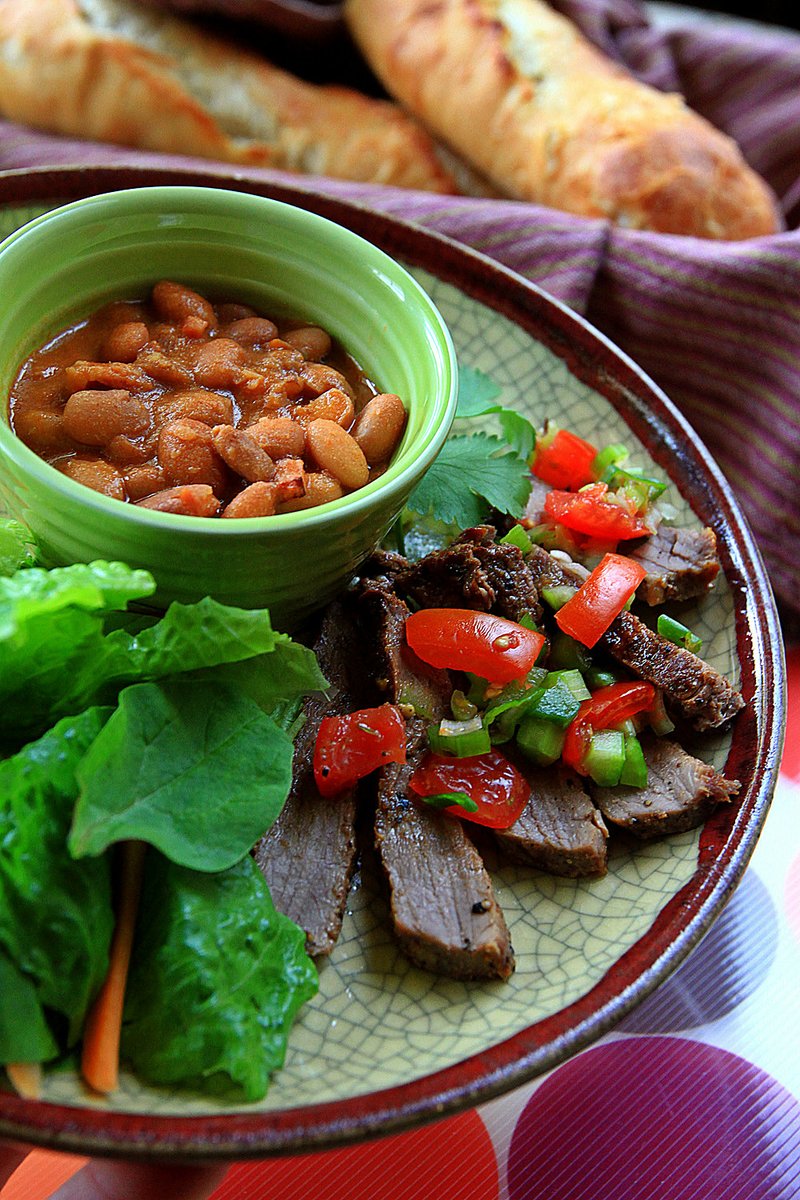LITTLE ROCK — When it comes to barbecue, most of us are familiar with the big boys: Memphis, Texas, Kansas City, the Carolinas. Some of us even know Korean. But there’s another barbecue out there, worthy of recognition.
It’s Santa Maria.
Santa Maria-style barbecue, originating in Central California’s Santa Maria Valley (about halfway between San Francisco and San Diego), is no ordinary barbecue. (Fans of Sideways may already be familiar with this barbecue, since a popular Santa Maria Valley restaurant, The Hitching Post, was featured prominently in the 2004 movie.)
The style, which dates to the mid-1800s, evolved from local ranchers’ and cowboys’ Spanish-influenced barbecuing techniques, according to santamariavalleybbq.com. Beef is the traditional meat. And there’s no sauce to overwhelm or mask the flavor.
But Santa Maria barbecue isn’t just a slab of beef tossed on a grill. The beef, historically top sirloin and tri-tip roast, is first seasoned with salt, pepper and garlic, then cooked over a wood fire. Surprisingly, fresh garlic is not part of the recipe.
The style is highly “localized,” as the tri-tip roast is a cut of beef locals claim to have “created” in the 1960s, and the wood used is from red oak trees native to the area. Slow-cooked pinquito beans, a variety grown only in the valley, are a must-have side dish. The traditional menu was even copyrighted in 1978 by the Santa Maria Chamber of Commerce. In addition to the beef and beans, a tossed green salad, macaroni and cheese, fresh salsa and French bread make up a meal.
But the list of localized ingredients doesn’t mean barbecue aficionados can’t try to duplicate the Santa Maria experience at home. Red oak grilling chips and pinquito beans can be bought online, or let regular hardwood smoking chips and pinto beans stand in for the regional requirements.
An excellent source for Santa Maria-style barbecue ingredients is susieqbrand.com, which sells red oak chips, pinquitos and the salt-peppergarlic seasoning blend, as well as prepared Santa Maria-style salsa. Another source for pinquitos (and other specialty dried beans) is ranchogor do.com.
As far as which wine to serve, take a note from Sideways and opt for a Santa Maria Valley or Santa Barbara Valley pinot noir or Syrah. Santa Maria-Style Beef
1 tablespoon salt 1/2 teaspoon ground black pepper 1/2 teaspoon garlic salt 1 (2- to 3-pound) tri-tip beef roast OR top sirloin, the thicker the better (do not remove fat) Red oak wood chips, soaked (see note)
In a small bowl, combine salt, pepper and garlic salt. Coat beef on all sides with salt mixture; let beef stand while you heat the grill. Prepare grill for high heat. For charcoal, use a combination of charcoal briquettes and red oak wood chips. For gas, fill smoking chamber with red oak chips. Sear the beef for 2 to 3 minutes on each side, then move beef to a cooler part of the grill and cook 20 to 30 minutes for medium-rare. Place the beef on a platter and cover with foil. Let it sit 10 to 15 minutes so juices can set. Remove excess fat, then slice on an angle across the grain. Makes 4 to 6 servings. Editor’s note: If red oak chips are not available, substitute other oak or hardwood; however, the flavor will not be the same.
Santa Maria-Style Salsa
3 medium fresh tomatoes, chopped 1/2 cup finely chopped celery 1/2 cup chopped green onions 1/2 cup finely chopped Anaheim or other green chile pepper 2 tablespoons snipped fresh cilantro 1 teaspoon vinegar Dash of Worcestershire sauce Pinch of garlic salt Pinch of dried oregano Few drops of hot pepper sauce
Combine all ingredients in a bowl, cover and let stand for one hour to blend flavors.
Pinquito Beans
1 pound dried pinquito beans (see note) 1 strip bacon, diced 1/2 cup diced ham 1 clove garlic, minced 3/4 cup tomato puree 1/4 cup red chile sauce 1 tablespoon dry mustard 1 teaspoon salt 1 tablespoon granulated sugar
Rinse and sort the dried beans, discarding any damaged beans or debris. Soak beans overnight in cold water. Then drain and rinse the beans. In a large pot, combine soaked beans and enough cold water to cover. Simmer 2 hours or until tender.
Saute bacon and ham until lightly browned. Add garlic and saute 1 to 2 minutes longer. Add tomato puree, chile sauce, mustard, salt and sugar.
Drain most of the cooking liquid off beans and stir in sauce. Simmer for 30 minutes. Keep warm until ready to serve.
Editor’s note: Pinquito beans are a cross between a small white bean and a small pink bean. They are grown exclusively in the Santa Maria Valley and can be ordered online. Pink and pinto beans are acceptable substitutes.
Recipes from Santa Maria Valley Chamber of Commerce
We make no claims of this recipe being authentic or even similar to Santa Maria barbecue, but we wanted to explore options for preparing this simple style of beef. This recipe can be prepared indoors and uses smoked salt to duplicate the robust smoke flavor that comes from cooking over an open, smoky fire.
Indoor Santa Maria-Inspired Beef
2 teaspoons salt 1 teaspoon smoked salt 1/2 teaspoon ground black pepper 1/2 teaspoon garlic powder 2 to 3 pounds top sirloin OR tri-tip roast, the thicker the better Vegetable oil
Heat oven to 500 degrees. In a small bowl combine salts, pepper and garlic. Coat meat in salt mixture. Lightly coat a cast-iron skillet with vegetable oil and place over high heat. When skillet is hot, add beef and sear on both sides. Transfer skillet with beef to oven and cook 10 minutes. Reduce oven to 350 degrees and cook until beef reaches an internal temperature of 140 degrees (about 15 minutes per pound). Let rest at least 10 minutes before slicing across the grain. Makes 6 to 8 servings.
Food, Pages 34 on 05/25/2011
